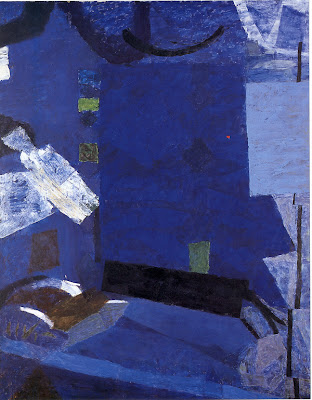(autoportrait)
Tadeusz Piotr Potworowski (1898-1962) is one of the few artists whose work may, or should, serve as a benchmark for the art of its times. Not in the sense of a measure or artistic standard, nor of the exploited idea of individuality (art history is after all concerned uniquely with individual achievement), but as an example of separateness which - for all its significant contribution to the surrounding art worldremains a thing apart. Piotr Potworowski's painting, developing, or- as Piotr Piotrowski would have it - dynamising itself between colourism and modernism, is perceived as an oeuvre evolving with a logical rhythm of its own from colourist beginnings, through the fullness and autonomy of expression in the artist's London years, to finding its place in forward-looking Polish art after his return to Poland in 1958. His pre-1939 works are staunchly Colourist, a quality they acquired during his studies at the Academy offine Arts in Krakow. In 1924 he left for Paris with the Capists, and though he broke with the formal constraints of their programme early on - exhibiting separately at the 38th Salon des Independants in Paris in 1927 - photographs of his works from the period: stilllifes, portraits, portraits in interiors indicate a marked affinity with colourist tenets, enhanced by studies of earlier masters such as Delacroix and an understanding of Cezanne, Matisse, Picasso, Bonnard and Leger. Echoes, rather than direct references to these artists are sometimes to be found in the drawings, gouaches, and watercolours that Potworowski produced concurrently with his paintings. He elaborated upon the colourist method by paying more attention to planes, making the background more decorative, and placing more emphasis on the relation between the figure and the interior it is depicted in. Subtler arrangements of colour are introduced, and the laborious process by which the Capists arrived at their texture is replaced by a relaxed approach to the outer surface of the pigment. In later years this would lead to techniques of rubbing in paint, applying semi-covering layers and delicate scumbling. The composition of Potworowski's works becomes coherent, balanced and disciplined, a result no doubt of his short stay in fernand Leger's atelier. His works on paper, done after returning to Poland in 1930 contain elements of expressive and surrealist imaging, best seen in a unique series of eight lithographs from 1934 dedicated to Edgar Allan Poe. He fought in the 1939 campaign, escaping after the capitulation to Lithuania and later Sweden, from ??˝where he came to England in January 1943. His paintings from the early 40s contain motifs known from previous years though made more expressive and dynamic. The years spent in England were a time of creative development for Potworowski, who then arrived at his mature idiom in painting. He found the artistic means to express fully his intent of synthesizing the specific impressions that drew him to a theme or motif- landscapes, figures in interiors, cityscapes - with his own multi-faceted perception of them. Descriptiveness gave way to a formal conciseness, barely hinting at the object. Potworowski experimented with forms, producing collages combining paint with a thickly-woven fabric. This amalgamation of impressions demanded a screening process whereby pictorial qualities would be made to represent the sum of colourist experience. It is unjust to consider Potworowski as a monochrome painter relying solely on complementary hues. His particular skill was the way in which he set the temperature of each painting, regardless of whether the colour scheme was cool or warm. Sometimes this was done by applying warm ground under a layer of cool tones, sometimes by defining the effect of the painting through the introduction of a small form, an accent enlivening space and colour. There are no set principles determining the colour scheme of these paintings, though each of them contains a colourist reaction to a whole set of factors conditioning the final representation. Potworowski returned to Poland in 1958, at a time when his position in Britain was well-established. Surprised by the conservatism of the Colourists and intrigued by the vigorous development of young Polish artists embracing modernity, he began working on paintings that were a reaction to the new circumstances while remaining faithful to his selected manner. The works were larger, with colour assuming greater expression and luminosity. His individual exhibition at the N ational Museum in Poznan in 1958 having confirmed his stature in Polish art, Potworowski decided to stay in Poland. He participated in many exhibitions and designed sets, costumes and posters for the theatre. His work gained verve, coming close to full self-realization and seemingly anticipating another breakthrough just before his sudden death in 1962. Piotr Potworowski - a painter, engraver, sculptor, teacher, set designer, critic and writer whose modest yet astounding output remains to be discovered in full. As do his extraordinary meditations contained in successive volumes of the monumental sketch??˝books he kept since 1952, and in the notebooks and letters shedding light on his art which he consistently kept separate from the joys and tribulations of everyday life. Jaroslaw Swierszcz
Jarosław Świerszcz
http://potworowski.art.pl/websites/71/390.html






















Hiç yorum yok:
Yorum Gönder